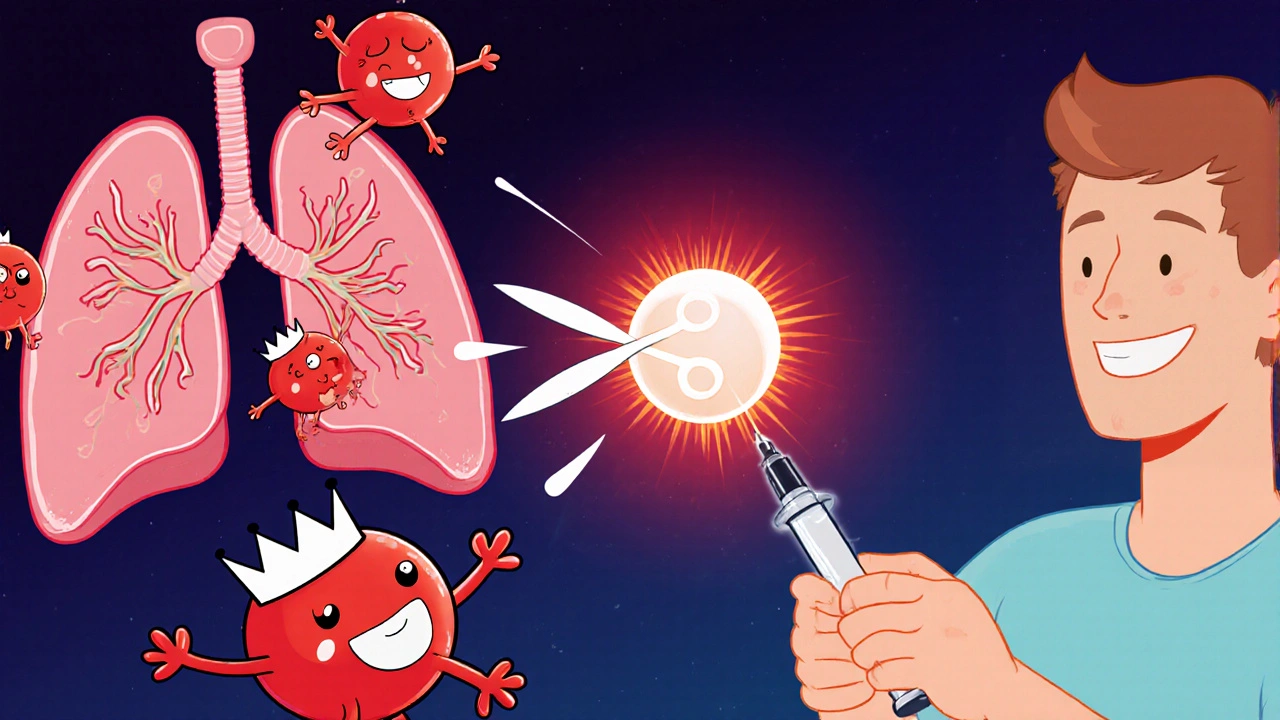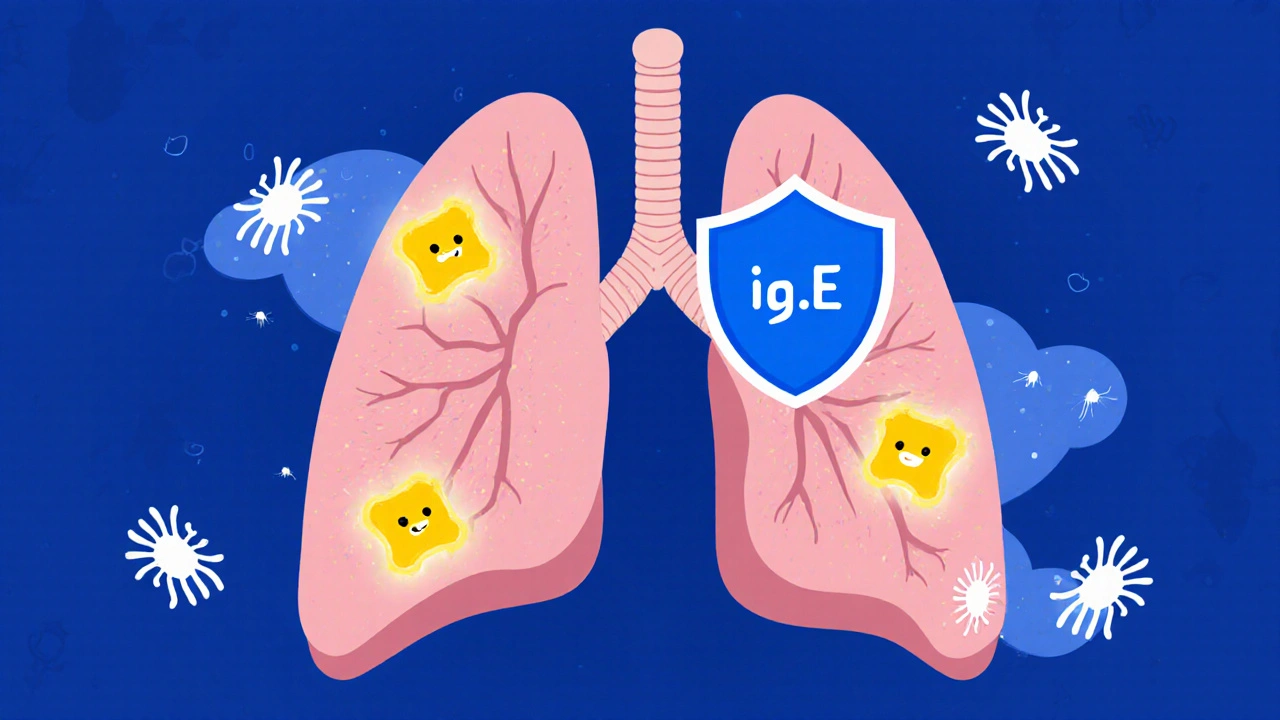What Are Biologics for Severe Asthma?
Biologics are not pills or inhalers. They’re targeted medicines made from living cells-often derived from mice or bacteria, then carefully changed to work in humans. These drugs don’t treat all asthma. They’re designed for one group: people with severe asthma who still struggle even when using the strongest inhalers, like high-dose corticosteroids and long-acting beta agonists. For these patients, biologics aren’t an extra option-they’re often the only thing that brings real relief.
Two major types dominate the field: anti-IgE and anti-IL-5. Each attacks a different part of the immune system’s overreaction that triggers asthma attacks. Anti-IgE, like omalizumab, stops allergic triggers before they start. Anti-IL-5, like mepolizumab and benralizumab, targets the white blood cells that cause airway swelling. Neither works for everyone. But for the right person, they can cut flare-ups in half-and sometimes eliminate the need for oral steroids entirely.
How Anti-IgE Therapy (Omalizumab) Works
Immunoglobulin E, or IgE, is the antibody that turns harmless things like pollen or dust mites into asthma triggers. In allergic asthma, your body makes too much IgE. It sticks to mast cells and basophils in your lungs. When you breathe in an allergen, these cells explode, releasing histamine and other chemicals that cause wheezing, coughing, and tightness in the chest.
Omalizumab (brand name Xolair) binds to free IgE in your blood before it can attach to those cells. No IgE binding = no explosion = fewer attacks. It’s only for people with confirmed allergic asthma-meaning you’ve tested positive for at least one perennial allergen, like house dust mites or cat dander, and your total IgE level falls between 30 and 1500 IU/mL. It’s approved for kids as young as six and adults.
Studies show omalizumab reduces severe asthma attacks by about 50%. In the INNOVATE trial, patients went from 3-4 ER visits a year to less than one. But it doesn’t work fast. Most people don’t feel better until after 3-4 months. And it won’t help if your asthma isn’t allergic. If your eosinophil count is high but your IgE is normal, omalizumab won’t touch your symptoms.
How Anti-IL-5 Therapies Target Eosinophilic Asthma
Not all severe asthma is allergic. Some is driven by eosinophils-white blood cells that swarm the airways and cause chronic inflammation. These patients often have high blood eosinophil counts (≥150-300 cells/μL) and high FeNO levels. This is called eosinophilic asthma.
Interleukin-5 (IL-5) is the signal that tells eosinophils to multiply and stick around. Anti-IL-5 drugs block that signal. Mepolizumab (Nucala) and reslizumab (Cinqair) latch onto IL-5 itself. Benralizumab (Fasenra) goes one step further: it attaches to the IL-5 receptor on eosinophils and literally kills them through a process called antibody-dependent cellular cytotoxicity. Within 24 hours of a benralizumab shot, eosinophil counts can drop by over 95%.
The results are dramatic. In the MENSA trial, mepolizumab cut exacerbations by 52%. In the ZONDA trial, benralizumab did the same. Patients reported fewer hospital stays, less reliance on oral steroids, and better lung function. One patient on Reddit shared that after six months on mepolizumab, her ER visits dropped from four a year to zero. Another said she went from taking prednisone every week to rarely needing it.

Key Differences Between Anti-IgE and Anti-IL-5
Choosing between these therapies isn’t about which is ‘better.’ It’s about which matches your asthma type.
| Feature | Anti-IgE (Omalizumab) | Anti-IL-5 (Mepolizumab, Benralizumab) |
|---|---|---|
| Target | Immunoglobulin E (IgE) | Interleukin-5 or its receptor |
| Best for | Allergic (atopic) asthma | Eosinophilic asthma |
| Required biomarker | Positive allergy test + IgE 30-1500 IU/mL | Blood eosinophils ≥150-300 cells/μL |
| Dosing | Every 2-4 weeks (based on weight and IgE) | Mepolizumab: every 4 weeks Benralizumab: every 4 weeks (first 3 doses), then every 8 weeks |
| Administration | Subcutaneous injection | Mepolizumab: subcutaneous Reslizumab: IV infusion Benralizumab: subcutaneous |
| Onset of effect | 3-6 months | 4-12 weeks (benralizumab faster for eosinophil drop) |
| Reduction in exacerbations | ~50% | 51-52% |
| Oral steroid reduction | Up to 50% | Up to 65% |
Benralizumab’s ability to destroy eosinophils quickly makes it stand out. But if you’re not eosinophilic, it won’t help. Omalizumab won’t work if you’re allergic to mold but your IgE is too low. Getting the right match depends on blood tests-not guesswork.
Who Gets These Treatments-and Who Doesn’t?
These aren’t first-line options. Before even considering a biologic, your doctor must confirm you’re doing everything right: using your inhaler correctly, taking it every day, avoiding triggers, and managing other conditions like acid reflux or sleep apnea that worsen asthma.
Then comes the testing. Blood eosinophils, serum IgE, FeNO (fractional exhaled nitric oxide), and a history of recent flare-ups. If you’ve had two or more exacerbations in the past year requiring oral steroids or ER visits, and you’re still uncontrolled on high-dose ICS/LABA, you might qualify.
But here’s the hard truth: about 30-40% of patients don’t respond. Why? Maybe your asthma has mixed triggers. Maybe your biomarkers are borderline. Maybe you’re taking steroids inconsistently. One patient in a 2022 study stopped benralizumab after three doses because of joint pain. Another saw no change at all. Biologics aren’t magic. They’re precision tools-and they only work if the problem fits the tool.

Cost, Access, and Real-World Challenges
These drugs cost between $25,000 and $40,000 a year in the U.S. Insurance rarely covers them without prior authorization-and that process can take up to three weeks. In Australia, Medicare subsidizes some biologics under the PBS, but strict criteria apply. Many patients wait months before starting.
Side effects are usually mild: soreness at the injection site, headache, or a sore throat. About 1 in 10 people get these. Anaphylaxis is rare-about 1 in 1,000 doses-but more likely if you’ve had severe allergic reactions before. That’s why the first few doses are given in a clinic.
Self-injection is common now. Most patients learn to do it at home after two or three supervised sessions. Auto-injector pens make it simple. But the cost and complexity still keep many out of reach. Only 1-2% of eligible patients globally are on biologics, even though up to 10% of asthma patients have severe disease.
What’s Next for Asthma Biologics?
Tezepelumab (Tezspire), approved in 2021, is a game-changer. It blocks TSLP, an early alarm signal from airway cells that kicks off multiple inflammatory pathways. Unlike anti-IgE or anti-IL-5, it works even if your eosinophils are low. Early data shows it helps across asthma types-not just allergic or eosinophilic. It’s the first ‘pan-phenotype’ biologic.
Next up? Longer-acting versions. A new formulation of benralizumab is in phase 3 trials that could mean just two shots a year. Researchers are also testing combinations-like pairing anti-IgE with anti-IL-5-to see if hitting multiple targets gives even better results.
But the biggest hurdle isn’t science. It’s access. Until costs drop and testing becomes routine, most people with severe asthma will keep suffering. Biologics have transformed care for those who get them. The challenge now is making sure more people can.
What Patients Say
Real stories tell the real story. One man in Perth, after 12 years of daily prednisone and ER trips, started omalizumab. After eight months, he stopped steroids completely. He now runs half-marathons.
Another woman in Sydney tried mepolizumab. Her lung function improved, but she got migraines. She switched to benralizumab-same results, no headaches.
And then there’s the one who tried all three and stopped after the third because of joint pain. She’s back on high-dose inhalers, hoping for something new.
There’s no one-size-fits-all. But for the right person, these drugs don’t just reduce symptoms. They give back a life.






Shawn Daughhetee
25 November, 2025 . 10:39 AM
I was on omalizumab for 2 years and it saved my life
Used to be in the ER every other month now I hike on weekends
Worth every penny even if insurance fights you
Justin Daniel
26 November, 2025 . 10:23 AM
so like... if you're allergic to your cat but your ige is 29... you're just screwed? 😅
Melvina Zelee
27 November, 2025 . 17:06 PM
i think the real magic isnt just the drug its the fact that doctors finally listen
for years they told me it was anxiety then stress then my posture
when they tested my eosinophils and said oh this is real... i cried
benralizumab didnt fix everything but it made me feel seen
ann smith
27 November, 2025 . 17:08 PM
It’s truly remarkable how far we’ve come in targeted asthma therapy. The reduction in oral steroid dependence alone is life-changing for many patients. I encourage anyone struggling to advocate for biomarker testing-knowledge is power.
Julie Pulvino
28 November, 2025 . 02:42 AM
my sister tried mepolizumab and got migraines too
switched to benralizumab and now she’s back to yoga and baking
but the cost? ugh
we spent 3 months on hold with insurance
just to get denied then appealed and won
if you’re eligible dont give up
Patrick Marsh
30 November, 2025 . 01:31 AM
Anti-IgE: requires IgE 30–1500 IU/mL. Anti-IL-5: requires eosinophils ≥150–300 cells/μL. Dosing: omalizumab every 2–4 weeks. Benralizumab: every 4 weeks, then every 8. Onset: 3–6 months for omalizumab. 4–12 weeks for anti-IL-5.
Danny Nicholls
30 November, 2025 . 13:05 PM
just got my first benralizumab shot today 🎉
my arm hurts but my lungs feel lighter already
also i now own a fancy auto-injector pen that looks like a space gun
who knew asthma treatment could be this cool 😎
Ravi Kumar Gupta
30 November, 2025 . 13:29 PM
in india we dont even have access to these drugs
my cousin with severe asthma uses nebulizers twice a day and still wakes up gasping
we pay 30% of our income just for inhalers
you talk about $40k a year
we dream of $40 a month
why does medicine have a price tag based on where you're born?
james lucas
2 December, 2025 . 07:41 AM
i remember when i first started omalizumab i was so skeptical like yeah right another fancy shot that wont do anything
but after 4 months i stopped needing my rescue inhaler during workouts
then i started running again
then i signed up for a 10k
now im training for a half marathon and i swear i forgot what it felt like to wake up with my chest tight
the docs said it might take 6 months but i felt better at 3
and the best part? i havent touched prednisone in over a year
its not magic its science
and if youve been told your asthma is just bad luck
get tested
you might be one blood test away from your life back